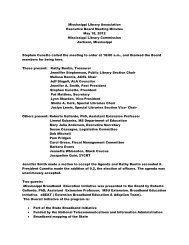Page 15 Vol. 67, No. 1, Spring 2003 <strong>Mississippi</strong> LibrariesThe Web in ReviewEdited by Steven Turner, The University of Southern <strong>Mississippi</strong>A Review of the Principia Cybernetica WebKenneth EvansAcquisition/Receiving Specialist& SLIS Graduate StudentThe University of Southern <strong>Mississippi</strong>kenneth.evans@usm.eduThe Principia Cybernetica is an onlinereference tool conceived by Soviet scientistValentin Turchin in the late 1980s; it isdesigned to explore philosophical and scientificquestions from a particularly cyberneticor systemic point of view. Given thatClaude Shannon’s mathematical theory ofinformation understands information asordered signals against a backdrop of noise(Gimon, 2002), and cybernetics as mainlyconcerned with information feedback incomplex systems, a database such as thePrincipia Cybernetica could prove usefulto librarians and information scientistsseeking to better understand their place inthe wider information revolution and cyberneticparadigm shift.An interesting aspect of this databaseis that it emphasizes the cyclical and networkednature of the medium it occupiesas a boon to understanding the subject itseeks to illuminate. That is, the Internetas a human/machine cybernetic systemis ideal for communicating ideas aboutcybernetic systems. Or as the PrincipiaCybernetica (PCP) says of itself:“Principia Cybernetica’s aim can bedefined as: integrating the knowledgeavailable in the domain of cyberneticsand systems science with the helpof cybernetic methods, as a first steptowards integrating the whole ofhuman knowledge available in thedifferent disciplines.”ACCURACY AND AUTHORITYEach article within the Principia is wellcross-referencedwith hypertext notes, aswell as being complete with references tooutside sources of information at the bottomof each webpage. The articles arewritten by academics for the use of academics,generally, but are accessible tothe lay person (or academics from otherfields) mainly due to the hyperlinked termsembedded in each article. The article on“the socio-technological singularity,” forinstance, was written by Francis Heylighen,a research professor at the FreeUniversity of Brussels (Vrije UniversiteitBrussel) working on the evolution of organizationalcomplexity, and a specialist incybernetics and cultural evolution.Although it is sometimes difficult for anon-specialist to know the accuracy orinaccuracy of any given article in a timelyway, often due to the technical nature ofthe subject, the database is built openlywith references to other sources, so thatany particular entry can be verified via theinformation given as reference-links andthrough the reference tools (an onlineglossary, etc.) within the Principia.COVERAGE AND CURRENCYThe Principia covers many subjectsand areas of knowledge pertaining towhat is called “systems science” andcybernetics. Under these auspices, thePrincipia examines the fields of informationscience, computer technology, biology,physics, mathematics, cosmology andphilosophy through the lens of holism,networks, and iterative systems. TheWebsite is rather extensive for this reason,and the coverage is, well, awesome.Principia is apparently modified monthly,with individual articles being updated asoften as weekly. An archive lists the topicscovered in each entry or article,chronologically or thematically, for yearsback.This database apparently endeavors toremain up to date, and it is obvious thatthe contributors are excited about theirtopics and strive to keep current in theirareas of academic inquiry.CONCLUSIONThe Principia is an amazing databasefor its ease of use, accuracy, imaginativeand helpful internal organization (thenumber of access points is staggering),and range of topics covered. It is accurate,current, and, despite its sometimesextreme technicality, user friendly.The Principia is more than just adatabase of information on topics relatingto systems. It and tools like it, due to thesubjects that it covers and the way thatsuch subjects are covered (i.e. cybernetically),could be at the vanguard of theinformation revolution. As Frijof Caprasays in his The Web of Life, an excellentintroduction to systems science, as it bearson biology and physics, science is nowturning its attention away from the myth ofmatter and toward the fact of energetic andinformational relationships (Capra, 1996,p. 6). The conceptual tools of cyberneticsare essential to information science, and,therefore, quite pertinent to librarians. In aworld increasingly built and busied by theexchange of information, systems scienceand cybernetics allows us to think furtherinto a truly networked and cyberneticfuture. The Principia and tools like it maybe in a most interesting, and perhaps evenpivotal, position to connect people andideas about the nature of the comingchanges during the coming changes.Check it out at http://pespmc1.vub.ac.be/REFERENCESCapra, F. (1996). The Web of Life. NewYork: Doubleday.Gimon, C. A. Heroes of Cyberspace: ClaudeShannon. INFONATION. RetrievedDecember 4, 2002, from http://www.skypoint.com/~gimonca/shannon.html
<strong>Mississippi</strong> Libraries Vol. 67, No. 1, Spring 2003 Page 16Tech Notes, et al.Column Editor: Rick Torgerson, Delta State UniversityGuidelines for Supervising andManaging a Cataloging DepartmentBy Ann BrantonHead of Bibliographic ServicesThe University of Southern <strong>Mississippi</strong>Ann.Branton@usm.eduIt is a truism that graduate school doesnot always prepare librarians for administrativejobs and supervisory responsibilitiesin cataloging. Most of us came upthrough the ranks, becoming very skilledin cataloging rules and MARC formats,but not necessarily in leadership, organizationalor management skills. Withoutopportunities to learn these skills prior toappointment, a cataloging manager mayonly gain experience through trial anderror. This can be a very tough, painfulapproach in training, too often yieldingonly marginally successful results.Appointments of department headsoften depend on seniority in the departmentrather than on searching out andselecting the best-experienced cataloglibrarian suited for administrative duties.Additionally, managing workflow andsupervising staff are related but differentresponsibilities; success in one does notguarantee success in the other. It wouldbe helpful for a new catalog departmenthead to have a roadmap, or perhapssome guidelines, as there are many waysto administer and direct a departmentwithin technical services. This article providessome basic concepts that any librarytechnical services department can implementregardless of the technology or theexperience of the manager.HOW TO ORGANIZEOrganizing the units or departments intechnical services will depend on: 1) thesize and economic health of the institution,and 2) the mission of the librarywithin that institution. Reflecting on thesetwo aspects of your institution is a goodplace to begin in organizing the followingunits in your technical services domain:acquisitions; cataloging; database maintenanceand authorities; and physical processingand preservation, which may alsoinclude binding, gifts and exchanges, andserials management. The most streamlineddepartments are found in fully integratedautomated library systems, where,for example, acquisitions duties can bemerged with cataloging. Other librariesmay adhere to more traditional lines intechnical services and perform manualand/or automated processes in a morestandard workflow. Most libraries fallsomewhere in between. In organizing,managing, and supervising the catalogingdepartment as a new manager, give carefulattention to: 1) the specific goals ofthe library and how the goals of technicalservices support them; 2) the internalorganization as well as the culture of eachindividual unit in technical services andhow integrated the workflow really is; and3) the management style of the supervisorsfor each unit. While this informationmay take a little time to gather and understand,it will help in formulating thevision, goals, and priorities of a catalogingdepartment under new leadership.VISION, GOALS AND PRIORITIESWhen employees understand thevision and goals of their library, they alsosee their place within that larger organization.If a vision statement is carefullyarticulated and communicated to staff, itgives focus to the routine and daily workflow.It is a good beginning in determiningwhat is important to the library as awhole so that all of the technical servicesstaff are in step with the library directorand other administrative personnel.Concerning the cataloging unit ordepartment, the primary question to askthe library administration is: will thelibrary support efficient and effectiveaccess to materials? If this is a priority ofthe library, it follows that the means andresources will be provided to support thisgoal. Accurate and timely cataloging ofmaterials is dependent on sufficient staffto perform the work, i.e., staff who arewell trained and well equipped to meetthe expectations of their library’s users,their supervisors, and their library’sadministration.Establishing priorities that are evaluatedseveral times a year keeps everyonefocused on the goal. Measurement andassessment on a monthly or quarterlyschedule will facilitate progress in achievingthe goals of the department. The catalogingand processing of materials ofmarginal value, such as county phonebooks, needs to be weighed against thecataloging and processing of materialsthat have research value and need full catalogingwith many access points to insureretrieval. Resources need to be allocatedto these materials categories in accordancewith their priority. Evaluating thedifferent kinds of subject materials andformats will also determine the skills necessaryto catalog and process them. Thisinformation will determine the number ofprofessionals and paraprofessionals neededto accomplish the job in the most costeffectiveand efficient manner.DIVISION OF LABORDividing up the workload can be donein several ways. Materials to be catalogedcan be divided by subject or academic
- Page 6 and 7: Page 5 Vol. 67, No. 1, Spring 2003
- Page 8 and 9: Page 7 Vol. 67, No. 1, Spring 2003
- Page 10 and 11: Page 9 Vol. 67, No. 1, Spring 2003
- Page 12: Page 11 Vol. 67, No. 1, Spring 2003
- Page 15: Mississippi Libraries Vol. 67, No.
- Page 19 and 20: Mississippi Libraries Vol. 67, No.
- Page 21 and 22: Mississippi Libraries Vol. 67, No.
- Page 23 and 24: Mississippi Libraries Vol. 67, No.
- Page 25 and 26: Mississippi Libraries Vol. 67, No.
- Page 27 and 28: Mississippi Libraries Vol. 67, No.
- Page 29 and 30: Mississippi Libraries Vol. 67, No.
- Page 31 and 32: MISSISSIPPI LIBRARYASSOCIATIONMEMBE














